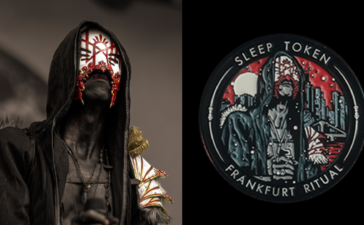When you look past the political turmoil, societal catastrophes and the seemingly neverending string of high-profile deaths, 2016 was a pretty good year. Especially so if you’re a fan of Australian punk and hardcore – we got career-defining records from bands like Violent Soho, Trophy Eyes, Ceres and Hands Like Houses, not to mention cracking debuts from acts like Cursed Earth, Sly Withers and Camp Cope.
But there was one particular album that outright defined 2016 for Australia’s alternative scene – an explosively honest and poignant outpouring of raw human emotion à la tearing riffs and venomous punk fury, weaved around grandiose Queen-esque histrionics and Broadway balladry. It’s an angst-driven rock opera so monolithic that it makes American Idiot look like a ska record. It is, of course, Opera Oblivia: the landmark third full-length from the rip-roaring Sydney stalwarts in Hellions.
When the glittery and atmospheric lead-in on ’24’ kicks over to a crunchy, overdriven pound of a fretboard, it becomes immediately clear that Opera Oblivia won’t be your standard mosh-ready fare. And when the last impassioned, belting refrain of ’25’ echoes out, you’d be forgiven for thinking what you just listened to was the product of years spent meticulously tinkering away.
But lo and behold, Hellions managed to pull off the impossible. Mere days separated the band’s transition from touring Indian Summer to demoing LP3, and when they landed in Bang Saray, Thailand to knuckle down with producer Shane Edwards (who’d been their unofficial sixth member since their earliest days as The Bride), they scrapped almost all of the material they’d hashed out in advance. Opera Oblivia came to life over three weeks at Karma Sound Studios, where the band would wake up, soak in the view, smash out whatever fantastical ideas came to mind, then knock off with a cocktail or 12.
Speaking to BLUNT today, Edwards proudly declares Opera Oblivia as one of the best projects he’s worked on to date, citing the complete freedom he and Hellions had to explore their wildest creative fantasies.
“We just broke down all the barriers and tried things that we normally wouldn’t, or that we’d normally hold back on,” he says. “We got really creative with a lot of sound design. For example, there was a big, fluffy sofa that sounded fantastic if you hit it with the palm of your hand. It was down in this empty concrete room underneath the studio, which we called ‘the dungeon’, and if you hit it, you’d get this big thundering sound. And you can hear that at the start of ‘Bad Way’, right before the first verse. We did lots of cool little Easter eggs like that – we tried to capture as many organic sounds as possible, then tweak them up and manipulate them.”
The process would end up having a critical impact on Edwards’ approach to production moving forward. Where he’d normally insist on listening to a band’s demos before they set foot in the studio, he went into the Opera Oblivia sessions mostly blind, which gave him an opportunity to tackle the record without any preconceived notion of what it needed to sound like – a lack of direction meant a lack of expectation. Because, as he puts it, “All of the best stuff you can do in the studio comes from the feeling and the emotion of the moment it comes out.”
To that end, a big part of any Hellions album is the visual scheme surrounding it. So when it came to representing the grandeur and the stately, cinematic scope of Opera Oblivia, they looked to the aesthetic of…Well, actual operas. The central artwork is framed in a ticket stub, this ghastly, authoritarian figure hovering pensively over a couple in the midst of a ballroom dance scene. It’s operatic, fittingly, implying to the listener that what they’re in for is something innately theatrical and baroque – something that feels much grander and more showy than anything Hellions have done prior – though still patently sinister.
To bring such a lofty vision to life, Pat Fox was a no-brainer. Fox and the band grew close after the Melbourne-native virtuoso inked the key art for Indian Summer, which made it obvious that Fox had a keen eye for composition – the way the Harbour Bridge lies under the setting sun, between the palm trees and apartment buildings all very intentionally laid out to provide a notable sense of depth and layering to what is, at face value, a very simple scene. From one perspective, you could argue he flipped the script for his Opera Oblivia cover – it’s a thematically dense scene, portrayed simply to intensify its impact.
As Fox muses to BLUNT, “We wanted it to look and feel a bit like a Playbill – like you could actually sit down and read through the booklet while you’re listening to the record as if you were at the theatre, reading through a Playbill as a show was going on in front of you.”
“We had a Skype call while the guys were in Thailand,” he continues, “And I remember literally coming up with the booklet idea while we were talking. I just grabbed a receipt that was in front of me and said, ‘Why don’t we do this mad foldout thing?’ So we actually had the packaging idea before we had the visuals. And then the way I approached the cover was to actually design it as a one-sheet, like a film poster rather than an album cover.”
Much in the way that Opera Oblivia opened Edwards’ third eye as a producer, Fox was moved by his experience working on the record. “I think it was just as much of a turning point for me, artistically, as it was for the boys with their music,” he affirms. “It’s one of the few things that I can look back on and still be proud of, which is a cool feeling to have.”
Hellions approved the artwork for Opera Oblivia during a layover between Thailand and the UK, where fresh off the hype of bashing out the beats, they were set to play a stack of festivals and club shows all over the shop. They had no time to fuck around, and with buzz around the band spreading like wildfire, they were keen to get the record out sooner than later. Which brings us to the part of the album-making story that every artist truly dreads: the moment they have to show it to their record label.
Because while Hellions themselves were stoked on the record, it’s no stretch to say that Opera Oblivia was an ambitious little beast. UNFD fell head over heels for Hellions because of their crunchy, balls-to-the-wall hardcore anthems, and here they were with what effectively plays out like a heavy musical. But even before release plans were locked in, the label knew they had a hit on their hands.
Luke Logemann, UNFD’s General Manager, Recorded Music, was particularly enamoured by the record’s third track, ‘Thresher’ – a punchy and powerful jam with an ultra-melodic, quasi pop-punk edge, and a chorus as anthemic as it is emotive: “Fuck you for not being strong enough / For letting me bear the weight of both of us / I can’t forever be your crutch / Today I think I’ve had enough”.
“I fell in love with this song the moment I heard it,” Logemann says. “It actually took me a while to understand the lyrics, but once I did it meant even more to me. There is a rawness and emotional honesty to ‘Thresher’ that makes it so nostalgic and romantic. In just three minutes, it takes you on such a journey that the final note feels like a deep breath out.”
Riding the high that lead single ‘Quality Of Life’ set, ‘Thresher’ sent Hellions soaring right into the iris of the public eye. The institution of triple j made it their go-to track to shake things up whenever the algorithm spat out too much mumble rap, and for the week of release, Opera Oblivia earned the highly coveted prize of becoming their feature album. It became the band’s first Top 5 charting record (for reference, Indian Summer came in at #19, and their latest LP, Rue, landed at #23), and even scored them an ARIA Award nomination for Best Hard Rock/Heavy Metal Album.
While we heaped praise on it upon its release, it wasn’t just us that did so. The team at Kerrang! were some of the record’s biggest champions, with then-editor Sam Coare lauding Hellions for “exploring and stretching every small corner of the rock world to create an album that staunchly defies categorisation.” Even the notoriously scrutinous Kill Your Stereo called it “life affirming, positive, and bloody catchy.”
It’s only been five years since Hellions dropped Opera Oblivia, but it’s already grown to become a bonafide classic for punk and emo fans around the world. So now there’s just one burning question: can they top it?









